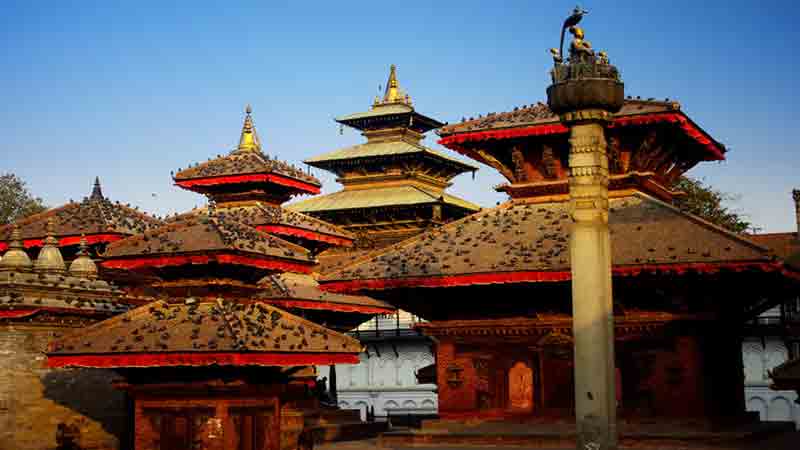Kathmandu Durbar Square, a UNESCO World Heritage Site, stands as a testament to Nepal’s rich history and cultural heritage. Nestled in the heart of Kathmandu, the capital city, this historical complex attracts thousands of tourists every year, eager to immerse themselves in its architectural splendor and historical significance.
Kathmandu Durbar Square, also known as Hanuman Dhoka Durbar Square, was the royal palace for Malla kings and later for the Shah kings of Nepal. The square’s name, “Hanuman Dhoka,” originates from the statue of Hanuman, the monkey god, at the entrance of the palace. The palace complex, which dates back to the 3rd century, was expanded significantly during the Malla period (12th to 18th centuries), and further modifications were made by the Shah rulers.
The square is a masterpiece of traditional Newari architecture, characterized by intricately carved wooden windows and doors, multi-tiered pagoda-style temples, and stone sculptures. Some of the notable structures within the square include the Taleju Temple, dedicated to the goddess Taleju Bhawani, which is only opened to the public once a year during the Dashain festival. The Kumari Ghar, home to the living goddess Kumari, is another highlight, where tourists can witness the age-old tradition of Kumari worship.
Kathmandu Durbar Square is not only a historical site but also a vibrant center for various cultural and religious festivals. The square comes alive during Indra Jatra, a festival celebrated in honor of Lord Indra, the god of rain and heaven. During this festival, chariots carrying the living goddess Kumari, Ganesh, and Bhairav are paraded around the city, attracting a large number of spectators, both local and foreign.
Another significant event is the Machhindranath Jatra, a chariot procession dedicated to the rain god Rato Machhindranath. This festival, which lasts for several weeks, showcases the rich cultural heritage of the Newar community and provides tourists with an opportunity to witness traditional rituals and dances.
The devastating earthquake of April 2015 caused significant damage to Kathmandu Durbar Square, with many ancient structures reduced to rubble. However, the restoration efforts, spearheaded by the government and various international organizations, have been remarkable. The restoration process has not only aimed to rebuild the damaged structures but also to preserve the historical authenticity and architectural integrity of the square.
Tourists visiting Kathmandu Durbar Square today can witness the resilience and dedication of the Nepali people in preserving their cultural heritage. The ongoing restoration works have also provided an opportunity for tourists to learn about traditional building techniques and the meticulous efforts involved in restoring ancient monuments.
For history enthusiasts and cultural aficionados, Kathmandu Durbar Square serves as a living museum. The square houses several museums, including the Hanuman Dhoka Palace Museum, which offers a glimpse into the royal history of Nepal. The museum exhibits various artifacts, including royal regalia, photographs, and historical documents, providing visitors with an in-depth understanding of Nepal’s monarchy and cultural evolution.
The Tribhuvan Museum, located within the palace complex, is another must-visit for those interested in the life and legacy of King Tribhuvan. The museum displays the personal belongings of the king, along with historical photographs and documents, offering insights into the political and social changes during his reign.
The area surrounding Kathmandu Durbar Square is bustling with local markets and shops selling traditional handicrafts, souvenirs, and antiques. Tourists can explore the narrow alleys and vibrant bazaars, where they can purchase exquisite handmade items, such as pashmina shawls, thangka paintings, metal statues, and wooden carvings. These markets not only provide a unique shopping experience but also contribute to the local economy by supporting artisans and craftsmen.
No visit to Kathmandu Durbar Square is complete without indulging in the local cuisine. The area is dotted with numerous eateries and restaurants offering a variety of traditional Nepali dishes. Tourists can savor delicacies such as momos (dumplings), dal bhat (lentil soup with rice), and Newari cuisine, which includes dishes like yomari (sweet dumplings), chatamari (Nepali pizza), and samay baji (a traditional Newari platter).
Dining in the vicinity of the square allows tourists to enjoy their meals while soaking in the historical ambiance and vibrant street life. Many restaurants also offer rooftop seating with stunning views of the square, providing a perfect setting to unwind and reflect on the day’s explorations.
Efforts to enhance the tourist experience at Kathmandu Durbar Square have been ongoing. Information boards and guided tours are available to help tourists understand the historical and cultural significance of the various structures within the square. Audio guides and mobile apps have also been introduced, providing tourists with a comprehensive and interactive way to explore the site.
In addition to the physical improvements, initiatives to promote sustainable tourism practices are being implemented. These include measures to manage the influx of tourists, minimize environmental impact, and preserve the site’s historical integrity. Local communities are actively involved in these efforts, ensuring that tourism development benefits both the heritage site and the local population.
Kathmandu Durbar Square stands as a testament to Nepal’s rich cultural heritage and historical legacy. Its intricate architecture, vibrant festivals, and living traditions make it a must-visit destination for tourists from around the world. Despite the challenges posed by natural disasters, the resilience and dedication of the Nepali people have ensured the preservation and restoration of this historical gem.
As tourists explore the ancient palaces, temples, and markets of Kathmandu Durbar Square, they are not only witnessing the grandeur of Nepal’s past but also contributing to its future. The square’s unique blend of history, culture, and vibrant street life offers an unforgettable experience, leaving visitors with lasting memories and a deeper appreciation for Nepal’s rich heritage.






